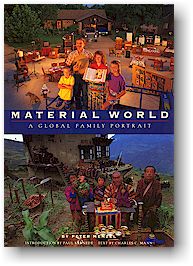| To Netnews Homepage Index |
|
 Peter Menzel Peter MenzelMaterial World - A Global Family Portrait 255 pages «I thought the world
needed a reality check. We all have an understanding of what our own lives are like, but even as the countries of the world become more interconnected, we know very little about the lives of other people in other societies. What better way to begin to understand than to show average family life around the world and to base that examination around a unique photograph of a family with all its possessions outside its dwelling?» - Peter Menzel, Afterword «Why in Mali do the women take care of all the work at home and most of the work in the fields? Why is it that the possessions of the Kalnazarov family in Uzbekistan overwhelmingly consist of carpets? Does our average Icelandic family play so much music because of the long winter nights?... What evidence of religious practices can be seen in these pages, from Korans to statues of the Virgin, reminding us that even in our Material World, most human beings feel a deep need for the transcendent and the intangible? It is all too easy to focus upon the material differences, precisely because that is what is most evident to the reader of this splendid volume.» - Paul Kennedy, Introduction «In honor of the United Nations-sponsored International Year of the Family in 1994, award-winning photojournalist Peter Menzel brought together 16 of the world's leading photographers to create a visual portrait of life in 30 nations. Material World tackles its wide subject by zooming in, allowing one household to represent an entire nation. Photographers spent one week living with a "statistically average" family in each country, learning about their work, their attitudes toward their possessions, and their hopes for the future. Then a "big picture" shot of the family was taken outside the dwelling, surrounded by all their (many or few) material goods. The book provides sidebars offering statistics and a brief history for each country, as well as personal notes from the photographers about their experiences. But it is the "big pictures" that tell most of the story. In one, a British family pauses before a meal of tea and crumpets under a cloudy sky. In another, wary Bosnians sit beside mattresses used as sniper barricades. A Malian family composed of a husband, his two wives, and their children rests before a few cooking and washing implements in golden afternoon light. Material World is a lesson in economics and geography, reminding us of the world's inequities, but also of humanity's common threads. An engrossing, enlightening book.» - Maria Dolan Data experts at the United Nations and World Bank helped to determine what an average family actually is in a country according to location (urban, rural, suburban, small town, village), type of dwelling, family size, annual income, occupation, and religion. Thirty countries were chosen from the 183 U.N. member nations to reflect a cross-section of the world: Albania, Argentina, Bhutan, Bosnia-Herzegovina, Brazil, China, Cuba, Ethiopia, Germany, Great Britain, Guatemala, Haiti, Iceland, India, Iraq, Israel, Italy, Japan, Kuwait, Mali, Mexico, Mongolia, Russia, South Africa, Spain, Thailand, United States, Uzbekistan, Vietnam, Western Samoa. Once a family was chosen, the photographer moved in with or very near to them. During the course of a week, a database on the family was assembled from a list of questions like "What is each family member's most valued possession?" or "What kind of future do they see for their children?". The book is complemented by profound statistical profiles. Last Updated Saturday, February 6, 1999 |
|
| To Netnews Homepage Index |